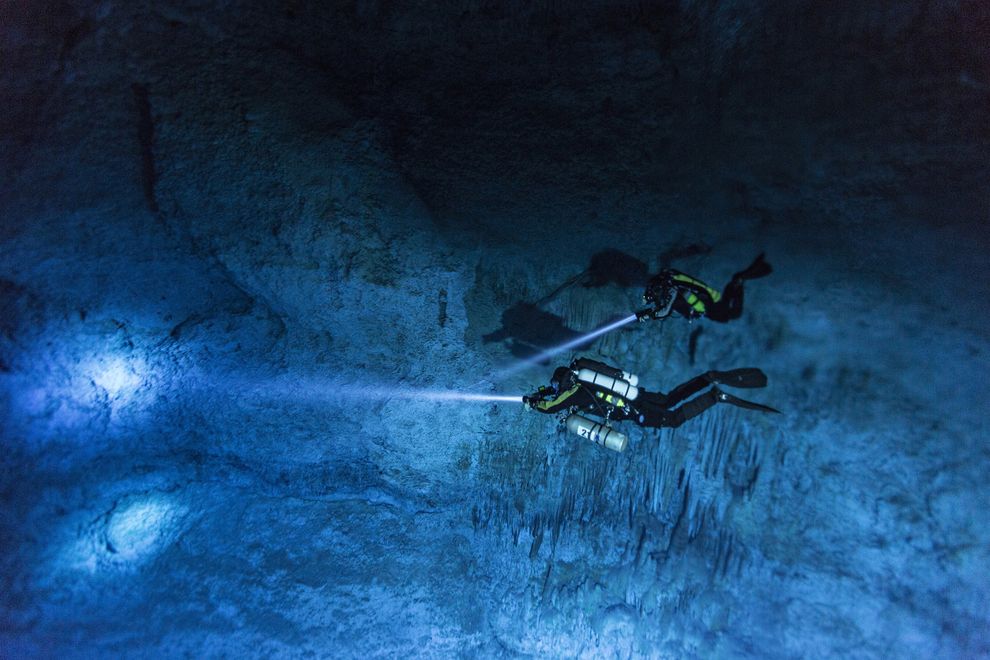It looks like you're using an Ad Blocker.
Please white-list or disable AboveTopSecret.com in your ad-blocking tool.
Thank you.
Some features of ATS will be disabled while you continue to use an ad-blocker.
10
share:
On Thursday, a team led by archaeologist James Chatters reported in the journal Science that they'd found a big piece of the puzzle: the most complete skeleton of such antiquity ever found in the Americas, between 12,000 and 13,000 years old. The skeleton contains both the craniofacial features of ancient Paleoamericans and mitochondrial DNA possessed by latter-day Native Americans.
he skeleton, dubbed "Naia" (an ancient Greek name related to water nymphs) by her discoverers, belonged to a teenage girl who fell more than 100 feet to her death nearly a half mile inside an elaborate network of karst caves that were largely dry at the end of the Pleistocene. Divers who found Naia in the cave on Mexico's Yucatán Peninsula named her watery grave Hoyo Negro ("Black Hole" in Spanish).
Without any bone collagen for radiocarbon dating, the team triangulated the skeleton's age by determining the age of calcite crystals known as "florets" growing on the bones, carbon-dating nearby bat guano, and carbon-dating Naia's tooth enamel.
A better video pretty pictures as any national geographic article, and much more on the importance of the finding and how it came to be, in the original article
Most Complete Ice Age Skeleton Helps Solve Mystery of First Americans
Some people really got nice jobs, dont you think?

Chatters speculates that ancient Americans' morphology may have changed as their living conditions changed. As highly mobile hunter-gatherers became more settled, evolutionary processes may have selected for more domestic traits and temperaments, resulting in the softer, rounder features seen in the faces of Native Americans.
"You start seeing these more domestic forms when females have more control over the food supply, when they're not so dependent on aggressive men," Chatters said. He added that this process of neotenization—the retention of some juvenile traits—can be seen in populations across the Northern Hemisphere between the late Pleistocene and modern times.
Ummm ok... makes sense? . Does that means native peoples of Africa, Australia, and the southern Pacific Rim never settled? if you dont know and you are not studying that you should just keep quiet.
Speculation about the potential drivers of evolutionary change is not part of the team's study.
edit on 16-5-2014 by Indigent
because: new video
a reply to: Indigent
I'd call that good science. It confirms the age of the bones in my mind.
Shows that teenage risk taking is alive and well in any era.
the team triangulated the skeleton's age by determining the age of calcite crystals known as "florets" growing on the bones, carbon-dating nearby bat guano, and carbon-dating Naia's tooth enamel.
I'd call that good science. It confirms the age of the bones in my mind.
Shows that teenage risk taking is alive and well in any era.
new topics
-
VP's Secret Service agent brawls with other agents at Andrews
Mainstream News: 1 hours ago -
Sunak spinning the sickness figures
Other Current Events: 1 hours ago -
Nearly 70% Of Americans Want Talks To End War In Ukraine
Political Issues: 2 hours ago -
Late Night with the Devil - a really good unusual modern horror film.
Movies: 3 hours ago -
Cats Used as Live Bait to Train Ferocious Pitbulls in Illegal NYC Dogfighting
Social Issues and Civil Unrest: 5 hours ago -
The Good News According to Jesus - Episode 1
Religion, Faith, And Theology: 7 hours ago -
HORRIBLE !! Russian Soldier Drinking Own Urine To Survive In Battle
World War Three: 9 hours ago
top topics
-
Florida man's trip overseas ends in shock over $143,000 T-Mobile phone bill
Social Issues and Civil Unrest: 12 hours ago, 8 flags -
SETI chief says US has no evidence for alien technology. 'And we never have'
Aliens and UFOs: 16 hours ago, 7 flags -
Cats Used as Live Bait to Train Ferocious Pitbulls in Illegal NYC Dogfighting
Social Issues and Civil Unrest: 5 hours ago, 7 flags -
VP's Secret Service agent brawls with other agents at Andrews
Mainstream News: 1 hours ago, 5 flags -
Former Labour minister Frank Field dies aged 81
People: 14 hours ago, 4 flags -
HORRIBLE !! Russian Soldier Drinking Own Urine To Survive In Battle
World War Three: 9 hours ago, 3 flags -
Bobiverse
Fantasy & Science Fiction: 12 hours ago, 3 flags -
Nearly 70% Of Americans Want Talks To End War In Ukraine
Political Issues: 2 hours ago, 3 flags -
Sunak spinning the sickness figures
Other Current Events: 1 hours ago, 3 flags -
Late Night with the Devil - a really good unusual modern horror film.
Movies: 3 hours ago, 2 flags
10
